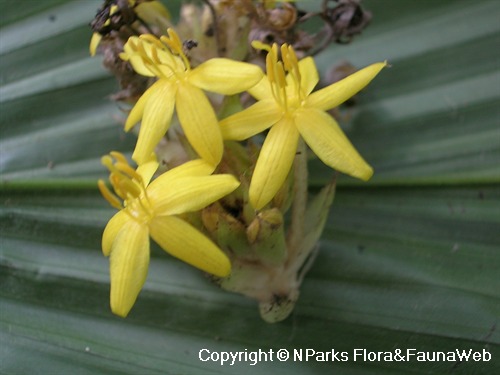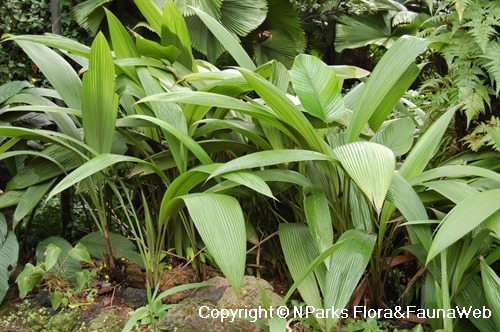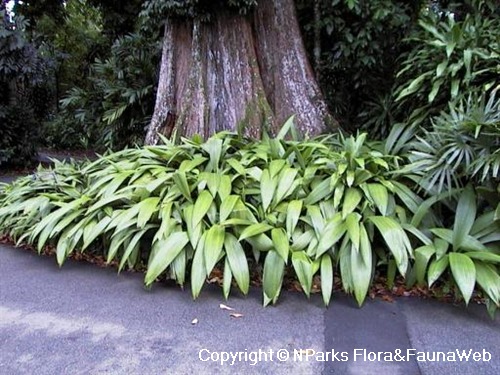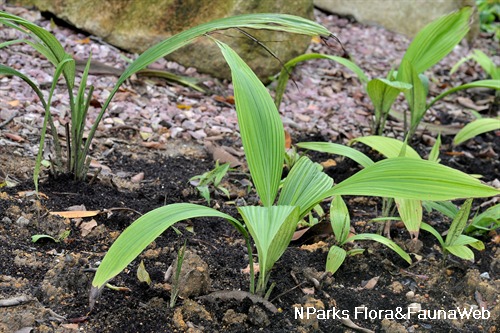
Back
Curculigo capitulata (Lour.) Kuntze
| Family Name: | Hypoxidaceae |
| Synonyms: | Molineria capitulata (Lour.) Herb., Curculigo glabra Merr., Curculigo capitulata (Lour.) Kuntze, Molineria sulcata Kurz, Molineria plicata Colla, Curculigo recurvata W.T.Aiton, Molineria recurvata (W.T.Aiton) Herb. |
| Common Name: | PaIm Grass, WeeviI LiIy, 大叶仙茅 |
Curculigo capitulata or Palm Grass is a understory plant found in damp, shaded areas of the forests. This hairy herb is rhizomatous, reaching to a height of 1 m tall. The leaves are elliptic, ribbed longitudinally, 60 - 150 cm long. Yellow flowers are produced in clusters at the base of the plant. Fruit is edible, whitish to green in colour, contains seeds embedded in white pulp. The leaves are frequently used in local communities to wrap food or transport goods.
Name
Classifications and Characteristics
| Plant Division | Angiosperms (Flowering Seed Plants) (Monocotyledon) |
|---|---|
| Plant Growth Form | Herbaceous Plant, Creeper |
| Mode of Nutrition | Autotrophic |
| Maximum Height | 1 m |
Biogeography
| Native Distribution | Nepal to South China and North East Queensland |
|---|---|
| Native Habitat | Terrestrial (Primary Rainforest, Secondary Rainforest) |
| Preferred Climate Zone | Tropical |
| Local Conservation Status | Native to Singapore (Critically Endangered (CR)) |
Description and Ethnobotany
| Growth Form | It is a hairy palm-like herb that can reach up between 0.6 m to 1 m tall. This herb is stemless, leaf stalks are directly attached to the rhizome underground. |
|---|---|
| Foliage | Its leaves are long, elliptic to lanceolate, ribbed longitudinally. Spare hairs can be found along the veins on the underside. The leaves have a smooth margin, pointed tip measuring at 60 - 150 cm long and 5 - 15 cm wide. The foliage is attached to a long petiole of similar length. |
| Flowers | Its flowers are borne on a head-like raceme inflorescence of 2 - 6 cm wide produced at the base of the plant. Flowers are yellow, deflexed, covered in wooly hairs, attached to a very short stalk (subsessile). |
| Fruit | Its fruit is whitish to green in colour, covered in hairs. The fruit is 7 - 8 mm by 6 - 6.5 mm, contains numerous seeds measuring at 1.5 - 2.3 mm wide, embedded in white pulp. |
| Habitat | It occurs in forests both primary and secondary, in wetter parts of the lowland rainforest, from sea level to 2000 m in altitude. Found growing as understory plant. |
| Cultivation | This species is easy to grow, tolerant to varying light conditions from full sun to full shade. It thrives well in moist well drained soil, rich in organic matter. |
| Etymology | The specific epithet, is the Latin adjective 'capitulatus', meaning small head in reference to the globose and compact inflorescences. |
| Ethnobotanical Uses | Others: Fruit is edible with a sweet taste. The leaves are utilised by local communities in Southeast Asia to wrap food, transport goods and obtain its fibres to make ropes and fishing nets. For example, the Lahu from Northern Thailand substitute Banana leaves with Molineria capitulata leaves to wrap food while the hill people in Philippines obtain the fibres to make false hairs. |
Landscaping Features
| Desirable Plant Features | Ornamental Foliage |
|---|---|
| Landscape Uses | General, Container Planting, Flowerbed / Border |
Plant Care and Propagation
| Light Preference | Semi-Shade |
|---|---|
| Water Preference | Moderate Water |
| Plant Growth Rate | Fast |
| Rootzone Tolerance | Easy to Grow, Fertile Loamy Soils, Moist Soils, Well-Drained Soils |
| Propagation Method | Seed, Division, Stolon / Runner |
Foliar
| Foliage Retention | Evergreen |
|---|---|
| Mature Foliage Colour(s) | Green |
| Mature Foliage Texture(s) | Raised / Sunken Veins |
| Foliar Type | Simple / Unifoliate |
| Foliar Arrangement Along Stem | Basal |
| Foliar Attachment to Stem | Sessile |
| Foliar Shape(s) | |
| Foliar Venation | Parallel |
| Foliar Margin | Entire |
| Foliar Apex - Tip | Acuminate |
| Leaf Area Index (LAI) for Green Plot Ratio | 3.5 (Shrub & Groundcover - Monocot) |
Non - Foliar and Storage
| Stem Type & Modification | Acaulescent |
|---|---|
| Root Type | Underground (Fibrous Root) |
| Specialised Storage Organ(s) | Underground (Rhizome) |
Floral (Angiosperm)
| Flower & Plant Sexuality | Bisexual Flowers , Bisexual Flowers |
| Flower Colour(s) | Yellow / Golden |
|---|
| Flower Grouping | Cluster / Inflorescence |
| Flower Location | Axillary |
| Flower Symmetry | Radial |
| Individual Flower Shape | Stellate / Star-shaped |
| Inflorescence Type | Raceme |
| Flowering Habit | Polycarpic |
Fruit, Seed and Spore
| Mature Fruit Colour(s) | White, Green |
|---|---|
| Fruit Classification | Simple Fruit |
| Fruit Type | Fleshy Fruit , Berry |
References
| References | Geerinck, D.J.L. (1993). Amaryllidaceae (including Hypoxidaceae). Flora Malesiana - Series 1, Spermatophyta, 11(2), pp. 353-373. Royal Botanic Gardens, Kew (continuously updated). Plants of the World Online | Kew Science. https://powo.science.kew.org/taxon/urn:lsid:ipni.org:names:64141-1. Accessed 21 February 2022. |
|---|
Image Repository
Others
| Master ID | 605 |
|---|---|
| Species ID | 1900 |
| Flora Disclaimer | The information in this website has been compiled from reliable sources, such as reference works on medicinal plants. It is not a substitute for medical advice or treatment and NParks does not purport to provide any medical advice. Readers should always consult his/her physician before using or consuming a plant for medicinal purposes. |




